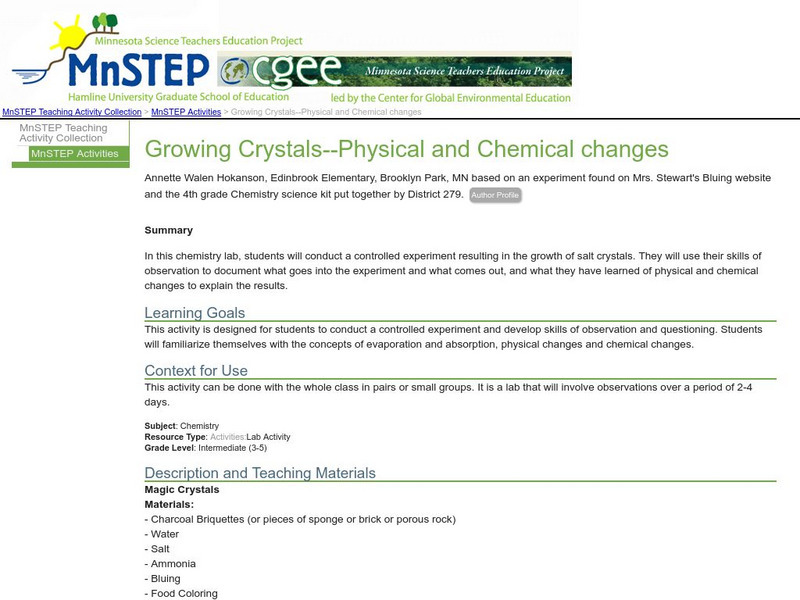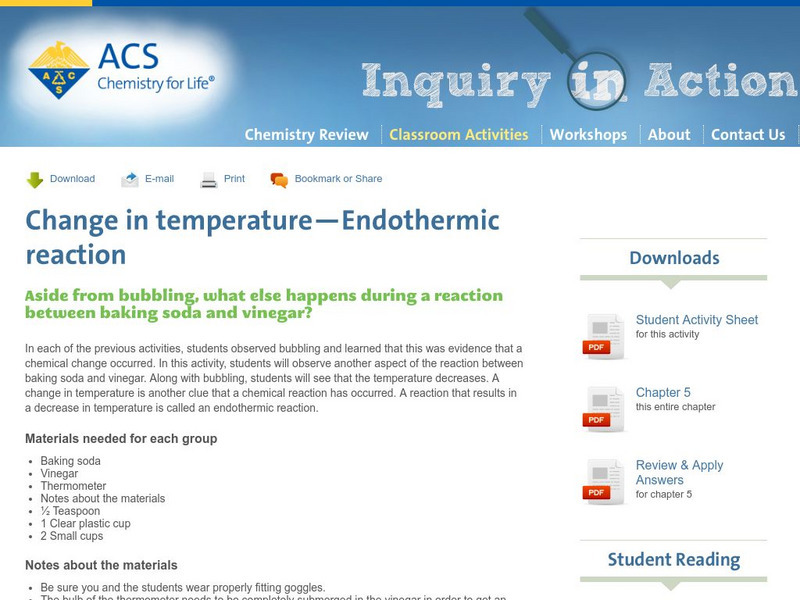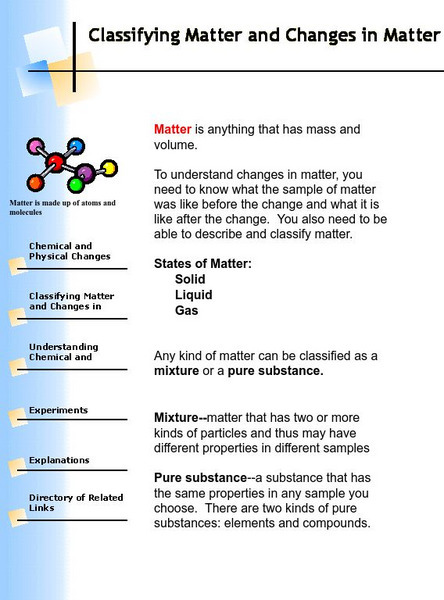Hi, what do you want to do?
Alabama Learning Exchange
Alex: Name That Change!
This lesson teaches students to distinguish between physical and chemical changes. Students will view an interactive slideshow presentation and then conduct experiments to discern physical and chemical changes.
Science Education Resource Center at Carleton College
Serc: Growing Crystals Physical and Chemical Changes
Students conduct a controlled experiment resulting in the growth of salt crystals. They will use their skills of observation to document what goes into the experiment and what comes out, and what they have learned of physical and...
American Chemical Society
Inquiry in Action: Change in Temperature: Endothermic Reaction
In this activity, students will observe another aspect of a chemical change which is a change in temperature. In this reaction, students will experiment with an endothermic reaction.
Concord Consortium
Concord Consortium: Chemical Reactions and Stoichiometry
In this activity, students explore reactions in which chemical bonds are formed and broken. Students experiment with changing the temperature and the concentration of the atoms in order to see how these affect reaction rates. They also...
Other
English Montreal School: Chemical vs. Physical Changes: Elements vs. Compounds
A laboratory experiment where students classify matter into a homogenous mixture, heterogeneous mixture, solution, or pure substance. Also students will test for physical and chemical changes.
American Chemical Society
Middle School Chemistry: Lesson Plans: Temperature and Rate of Chemical Reaction
Students experiment to see if the temperature of two clear colorless solutions affects how fast they react.
Alabama Learning Exchange
Alex: Chemical Reaction in a Bag
Students will use scientific methods in creating and observing a chemical reaction.
Science Education Resource Center at Carleton College
Serc: Egg Experiments
Two experiments where students investigate with uncooked eggs. In the first investigation, they explore how to remove the eggs outer shell while keeping the rest of the egg intact. In the second, students attempt to shrink the egg...
Science Education Resource Center at Carleton College
Serc: Does Salt & Vinegar Have an Effect on Pennies?
During this lab students will experiment to see whether a salt and vinegar solution can clean a tarnished penny. Included on site is lesson plan and student worksheet.
Other
The Science House: Ziptop Bag Chemistry
In this experiment, three reactions are performed in a sealed Ziploc bag so that they can be observed. Students identify whether physical or chemical change has taken place.
Other
Science Alive: Changing the Starch in "Yams" to Sugar
This lab activity provides students with the experience of using their own enzymes to convert starch to sugar (a disaccharide called maltose), then testing to see if the conversion has taken place.
Utah Education Network
Uen: Physical Changes
Second graders explore the concept of law of conservation of mass.
Maryland Science Center
Maryland Science Center: Create a Kitchen Chemistry Kit [Pdf]
Instructions for how to safely create a chemistry set using basic ingredients found around the home. Provides two experiments to try, one involving a physical change and the other a chemical change.
Utah Education Network
Uen: Trb 5:1 Act. 4: Chem. Reactions Borax & Glue, Cream
For this experiment for Grade Five, students develop an understanding that chemical changes in matter do not affect the actual mass of the matter.
Other
The Science House: Dancing Spaghetti
The chemical change of matter is illustrated in this lab experiment when spaghetti is placed in a solution of baking soda and vinegar. Watch the spaghetti rise to the surface and sink again once the gas is released.
Center of Science and Industry
Cosi Columbus: A Swell Activity With Beans [Pdf]
Learn about absorption in this hands-on science experiment. Includes full list of materials, procedures, and scientific explanation of what happens to different types of beans as they soak in water in a test vial.
Other
The Science House: Combustion
In this experiment, students will observe that the weight of the product of combustion is greater than that of the starting material. Teacher's notes address the key concepts of this experiment.
Other
Classifying Matter and Changes in Matter
Learn to identify changes in matter and explain what happens as matter changes. The lesson is supplemented with several experiments to reinforce key concepts.
ClassFlow
Class Flow: Reversible and Irreversible Change
[Free Registration/Login Required] This unit brings together and consolidates work that children have done before on reversible changes and introduces irreversible changes. Students are guided through experiments illustrating the...
American Chemical Society
American Chemical Soc.: Best of Wonder Science: Temperature Touch O Meter [Pdf]
An experiment to explore how one's sense of touch experiences changes in the temperature of water.
Davidson College
Davidson College: Le Chatelier's Principle: Effect of a Change in Temperature
Explains how Le Chatelier's Principle is used to predict how a temperature change affects a system's chemical equilibrium and presents a virtual experiment where the effect is explored. Requires Java.
Davidson College
Davidson College: Le Chatelier's Principle: Effect of a Change in Volume
Explains how Le Chatelier's Principle is used to predict how a volume change affects a system's chemical equilibrium and presents a virtual experiment where the effect is explored. Requires Java.
Utah Education Network
Uen: Science Detectives
Students are given a scenario for this lesson where they must use investigative skills like a detective would to decide whether changes that happen to objects in the story are physical or chemical. They then conduct an experiment with...
Museum of Science
Museum of Science and Industry: Online Science: Create Gas
Follow these simple, step-by-step instructions to create and observe the results of the chemical reaction between vinegar and baking soda.



















